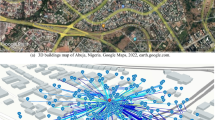Abstract
This paper is concerned with a numerical simulation of electric field distributions in urban areas by using the 1-ray model combined with 2-ray model. Introducing amplitude modification factor \( \alpha \) and propagation order \( \beta \) of distance, this model is arranged so that we can deal with propagation in complicated electromagnetic environments. We show that the two parameters \( \alpha \) and \( \beta \) can be obtained from Hata’s empirical equations. In this paper, we propose an estimation method for the electric field distributions in complicated propagation environments in addition to those areas defined by the Hata’s equations by employing statistical data such as building coverage and floor area ratios. Numerical analyses are carried out to show an example of distribution of amplitude modification factor \( \alpha \) in Fukuoka city.
Access this chapter
Tax calculation will be finalised at checkout
Purchases are for personal use only
Similar content being viewed by others
References
Uchida K, Honda J (2010) Estimation of propagation characteristics along random rough surface for sensor networks. In: Merret GV, Tan YK (eds.) Wireless sensor networks: application-centric design, Chapter 13. InTech, pp 231–248
Uchida K, Honda J (2011) An algorithm for allocation of base stations in inhomogeneous cellular environment. In: Proceedings of 2011 international conference on network-based information systems (NBiS-2011), pp 507–512, Sept 2011
Hata M (1980) Empirical formula for propagation loss in land mobile radio services. IEEE Trans Veh Technol VT-29(3):317–325
Uchida K, Honda J, Yoon KY (2011) An algorithm for rough surface generation with inhomogeneous parameters. J Algorithm Comput Technol 5(2):259–271
Honda J, Uchida K, Yoon KY (2010) Estimation of radio communication distance along random rough surface. IEICE Trans Electron E93-C(1):39–45
Uchida K, Honda J, Tamaki T, Takematsu M (2011) Two-rays model and propagation characteristics in view of hata’s empirical equations. IEICE technical report AP2011-14:49–54
Uchida K, Honda J, Lee JH (2011) A study of propagation characteristics and allocation of mobile stations. IEICE technical report IN2011-98:31–36, MoMuC2011-32:31–36
Uchida K, Honda J, Yoon KY (2009) Distance characteristics of propagation in relation to inhomogeneity of random rough surface. In: Proceedings of 12th international symposium on microwave and optical technology, pp 1133–1136, Dec 2009
Uchida K, Takematsu M, Honda J (2012) An algorithm to estimate propagation parameters based on 2-ray model. In: Proceedings of NBiS-2012, Melbourne, pp 556–561, Sept 2012
Uchida K, Takematsu M, Lee JH, Honda J (2012) Field distributions of 1-ray model using estimated propagation parameters in comparison with DRTM. In: Proceedings of BWCCA-2012, Victoria, pp 488–493, Nov 2012
Mushiake Y (1985) Antennas and radio propagation. Corona Publishing Co. Ltd, Tokyo
Collin RE (1985) Antennas and radiowave propagation. McGraw-Hill, New York
Shigetomi K, Honda J, Uchida K (2012) On estimation of amplitude modification factor and propagation order of 1-ray and 2-ray models in comparison with Hata’s equations. In: Proceedings of KJJC-2012, Seoul, Korea, pp 145—148, May 2012
Press WH, Flannery BP, Teukolsky SA, Vetterling WT (1992) Numerical recipes in FORTRAN: the art of scientific computing, 2nd edn. Cambridge University Press, Cambridge, pp 99–122
Acknowledgments
The work was supported in part by a Grand-in Aid for Scientific Research (C) (24560487) from Japan Society for the Promotion of Science.
Author information
Authors and Affiliations
Corresponding author
Editor information
Editors and Affiliations
Rights and permissions
Copyright information
© 2013 Springer Science+Business Media Dordrecht
About this paper
Cite this paper
Uchida, K., Shigetomi, K., Takematsu, M., Honda, J. (2013). An Estimation Method for Amplitude Modification Factor Using Floor Area Ratio in Urban Areas. In: Park, J.J., Barolli, L., Xhafa, F., Jeong, H.Y. (eds) Information Technology Convergence. Lecture Notes in Electrical Engineering, vol 253. Springer, Dordrecht. https://doi.org/10.1007/978-94-007-6996-0_11
Download citation
DOI: https://doi.org/10.1007/978-94-007-6996-0_11
Publisher Name: Springer, Dordrecht
Print ISBN: 978-94-007-6995-3
Online ISBN: 978-94-007-6996-0
eBook Packages: EngineeringEngineering (R0)




